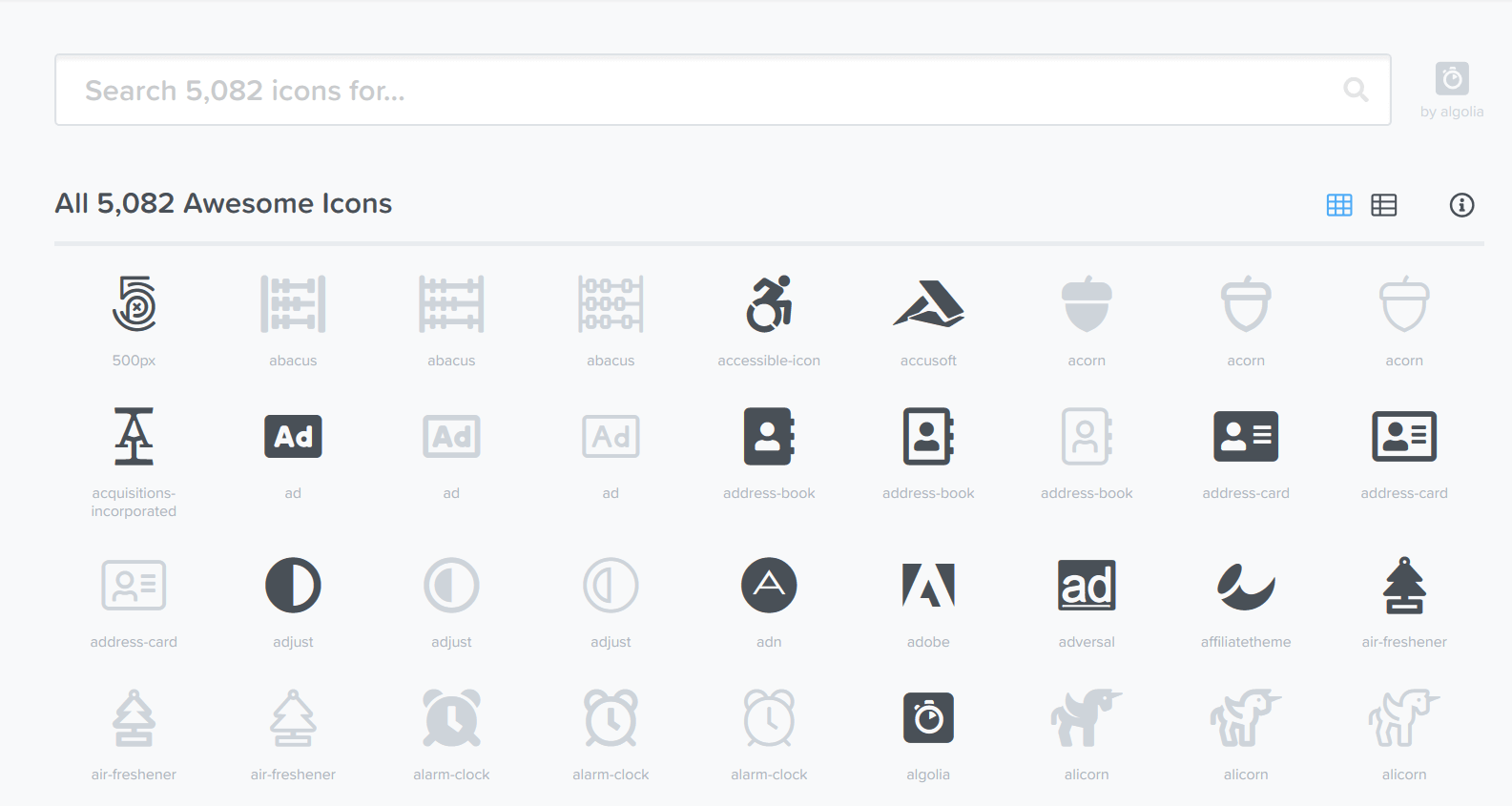今日推荐开源项目:《图标库 Font-Awesome》
今日推荐英文原文:《Yet Another Top Ten List of Popular Programming Languages》

今日推荐开源项目:《图标库 Font-Awesome》传送门:GitHub链接
推荐理由:为你的页面上添加各种各样你想得到或者想不到的图标用来装饰或者引导。这个库可以让你从众多图标中选出你喜欢的那个——兴许你需要搜索一会,因为它提供的图标非常之多,总数达到了五千以上。如果你需要对它们中的一些进行样式的修改的话,也可以直接在 CSS 中添加自己的规则。

今日推荐英文原文:《Yet Another Top Ten List of Popular Programming Languages》作者: Deepu Benson
原文链接:https://opensourceforu.com/2019/03/yet-another-top-ten-list-of-popular-programming-languages/
推荐理由:一个稍微有点不同的十大流行编程语言
Yet Another Top Ten List of Popular Programming Languages
In this article, I will provide three different lists of programming languages for professionals with different needs. The first list will use the selection criterion of popularity. The second list will feature programming languages that gained in popularity in the four most popular rankings of languages (the TIOBE Index, the RedMonk Programming Language Rankings, the PYPL or PopularitY of Programming Language Index, and the IEEE Spectrum Ranking of Programming Languages) over the past three years. The criteria for selecting programming languages for the third list are similar to the first list, with the additional parameter being programming languages that had their first release in the last ten years.The top 10 programming languages for 2019 in terms of popularity are:
- Java
- C
- C++
- Python
- C#
- PHP
- JavaScript
- Objective-C
- R
- Swift
The other newcomer in the top ten list is R, an open source programming language for statistical computing, making it the only scientific programming language in the top ten list. The increase in the number of data mining applications is reflected in the rising popularity of R.
The two programming languages left out of the list are Ruby and Go. With the strong support of Google, Go might make a comeback into the top ten list in the future. However, with many pundits writing off Ruby as a doomed programming language, its future popularity is debatable. Although this list is free of any biases, as mentioned earlier, the entries in the list are again highly predictable. Moreover, most of these languages are expected to retain their position in the coming years too. Well, that is one drawback of this listing of top ten popular programming languages.
The winners and losers in the programming world
Now that we have our top ten list, let us move forward. What about a programmer who wants to know about programming languages that are gaining popularity? Well, the lists discussed next are intended for such people. For this list of programming languages that are gaining popularity, I have again consulted the afore mentioned four rankings. First, the programming language should be one of the top twenty in the four rankings for the past three years. Second, the popularity of the programming language should have continuously increased in all the four rankings for the past three years. Though I wanted to come up with a long list, the only eligible programming languages that met both parameters were Python and JavaScript. Even though the popularity of both Python and JavaScript is increasing, the growth of Python is phenomenal. If these trends continue for a few more years, then Python might become the most widely used programming language in the world –if it hasn’t already. The inclusion of Python and JavaScript is not surprising, but the exclusion of Swift and Go is. Both these languages have shown a slight decrease in their ratings in the TIOBE Index. The TIOBE Index uses the search volume in popular search engines such as Google, Bing, etc, and websites like Wikipedia and YouTube as the criteria for measuring the popularity of a programming language.The reason for the slight decline in Web searches for Swift and Go need not necessarily be a drop in popularity. One reason could be that when a programming language becomes sufficiently popular, enough offline materials like textbooks and articles are published, which in turn might reduce casual Web searches.
Though I don’t want to belittle somebody’s favourite programming language as ‘not popular any more’, I was curious enough to find out if any one programming language has gone down in popularity in all the four rankings for three consecutive years. Here, I have considered programming languages which are in the top twenty in at least one of the four rankings. The list again contains two programming languages, Ruby and Perl. Their decrease in popularity is slight, so these trends may not mean that Ruby and Perl are going to be extinct soon. But, at the same time, I believe it is high time for the communities and practitioners of these two programming languages to analyse the reason for this slight but steady decline. Being an occasional user of Perl, this warning applies to me also.
The young competitors in the programming world
Though we have discussed three different lists so far, with the third one being slightly disturbing, we haven’t had many surprises. The top ten list of popular programming languages has many solid members which are highly predictable. The second list which states that Python and JavaScript are becoming more and more popular is just a confirmation of an industry wide belief. The third list that suggests that Ruby and Perl are becoming less popular nowadays is again a widely held belief, though not necessarily true.So, now I am going to make one more list that will have a lot of surprises and be very useful to programmers who want to learn and work with the latest programming languages trending in the industry. The selection criteria for this list are the following – only those languages that had their first release on or later than January 2009 have been considered for inclusion. Second, since the four different ranking schemes have a different number of programming languages present in them, only those languages that are in the top 50 in at least one of the four rankings have been selected.
The first language included in this list is not surprising at all – Swift, a programming language that was first released in 2014. Swift was in the top ten list of popular programming languages published in OSFY in 2017, and is present in the 2019 list given above too. Though Swift was initially a proprietary programming language, from version 2.2 onwards it got open sourced and became available under Apache License 2.0. Swift has syntactical similarities with Objective-C.
A close runner-up in the list is Go, a programming language first released in 2009, developed by Google. Go (often called Golang) is an open source programming language released under the BSD licence. Go is syntactically similar to C. It was in the top ten list in 2017, and has narrowly missed out on a place in the 2019 list.
The next programming language included in the list is Rust, which was first released in 2010. Rust is a system programming language whose syntax is similar to C++. It supports both functional and imperative programming paradigms. Rust is an open source programming language released under the MIT License and Apache License 2.0.
The next entry in the list is Kotlin, a statically typed programming language which was first released in 2011. Kotlin runs over the Java virtual machine and is widely used for Android app development. Kotlin has been released under the Apache licence.
The next entry in the list of promising programming languages is Julia. Even though Julia is a general-purpose programming language, it is used a lot for numerical and computational analysis, making it mainly a scientific programming language. Julia is released under the MIT licence and GNU General Public License Version 2.
The next entry in the list is TypeScript, which is developed by Microsoft and was first released in 2012. But, to our surprise, it is also an open source programming language released under Apache License 2.0. A big advantage of TypeScript is that it is a superset of JavaScript; so existing JavaScript programs are valid as TypeScript programs also.
The final entry in the list of promising programming languages is Dart, a general-purpose programming language first released in 2011. It is yet another language that’s developed by Google. Dart has been released under the BSD licence. The syntax of Dart is similar to the C programming language.
So, the final list of seven promising programming languages features Swift, Go, Rust, Kotlin, Julia, TypeScript, and Dart. There is a high probability that at least a few of these will be permanent fixtures in the top ten lists in the near future itself. So, it would be a good idea to start learning some of them, if you are a serious developer.
Do remember that I haven’t created these lists based on my personal preferences. So, if your favourite programming language is absent from a particular list, rather than blame me, remember that I was merely an aggregator of facts found in the four ranking schemes with specific biases. It will be highly beneficial if the readers go through the four ranking schemes (mentioned at the beginning of the article) further to elicit more information regarding the popularity of these programming languages. In addition to these four ranking schemes, I urge the readers to go through the Stack Overflow Developer Survey also. This survey began in December 2010 and has been conducted annually ever since. The results of the latest survey conducted in December 2018 are available at https://insights.stackoverflow.com/survey/2018/. This survey not only analyses the popularity of programming languages but also examines the social, economical and psychological aspects of programmers and their lives.
下载开源日报APP:https://openingsource.org/2579/
加入我们:https://openingsource.org/about/join/
关注我们:https://openingsource.org/about/love/
